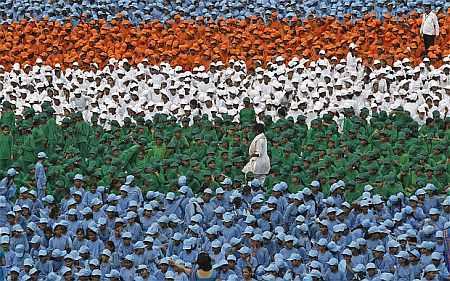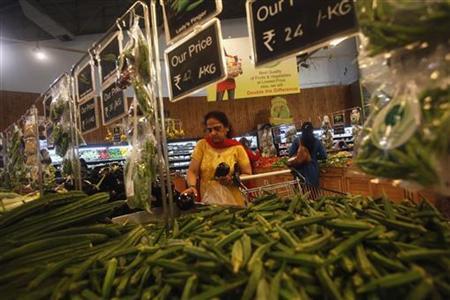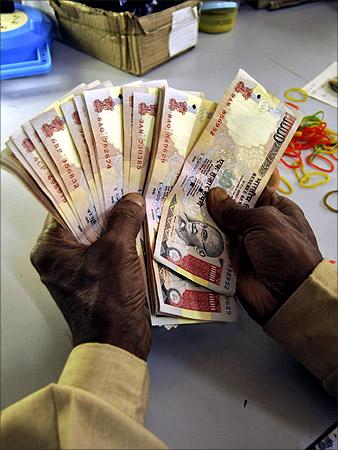Photographs: Reuters Arvind Subramanian
It is striking that India's economy has experienced close to double-digit inflation for more than three years, among the highest in the world, and nearly twice as high as politics was thought to permit, writes Arvind Subramanian
The Indian government's recent reforms to reduce government subsidies and embrace greater foreign direct investment were unexpected and bold.
Markets have rewarded them with surging stock prices and a rebound in the value of the rupee.
The reforms may yet be reversed or diluted because of the political backlash.
Their impact may be more symbolic than substantive.
Nevertheless, they are significant in that they reflect changes in the operating assumptions of Indian politics.
For a long time, maximising electoral success required politicians to act as if there were a ceiling of about five per cent on inflation and virtually no ceiling on fiscal populism.
. . .
Why people now are so keen about growth
Photographs: Reuters
It is striking that India's economy has experienced close to double-digit inflation for more than three years, among the highest in the world, and nearly twice as high as politics was thought to permit.
Remarkably, there has been no domestic uproar.
This growing indifference to high inflation seems to be the result of the rise in real incomes that has accompanied high growth.
Even in rural India, wages have been rising much more rapidly than inflation thanks to government policies, including an extensive employment guarantee scheme.
Moreover, a shrinking public sector means that fewer people earn the fixed incomes most vulnerable to being eroded by high inflation.
. . .
Why people now are so keen about growth
Photographs: Ajay Verma/Reuters
In other words, it is growth and real incomes that are increasingly important for the government and the economy to deliver.
Even after the global crisis of 2008, India's growth appeared to be cruising at about eight per cent.
In these circumstances, the government did not feel obliged to undertake growth-enhancing reforms.
Nor was there any serious attempt to squeeze double-digit inflation out of the system -- for fear that growth, which voters had come to take for granted, would suffer.
But when growth recently began to fall below five to six per cent and, critically, when this deceleration began to seem more permanent, panic galvanised policy makers into action.
. . .
Why people now are so keen about growth
Photographs: Danish Siddiqui/Reuters
Their resolve was strengthened by the threat of downgrading by the rating agencies, which would have further undermined investor confidence and growth.
Reform was made easier by the replacement of Pranab Mukherjee, an elderly Congress apparatchik, with Palaniappan Chidambaram, a decisive reformist, as minister of finance. And while the monetary authorities did not cut interest rates to boost growth further, their inaction, given the acceleration in inflation, amounted to loosening of policy.
In fact, it is telling about the shifting emphasis between combating inflation and reviving growth that despite policy interest rates barely being positive, the expectation was of a cut in these rates rather than an increase.
. . .
Why people now are so keen about growth
Photographs: Vivek Prakash/Reuters
If politicians are now more concerned to maintain high growth than to avoid high inflation, what about fiscal populism?
Since the current government came to power in 2004, it has presided over a steady expansion in social expenditure, comprising employment guarantee schemes, subsidies for fuel, fertiliser, food and power and increases in the prices paid to farmers for key commodities.
Real government expenditure per capita has doubled during the past decade.
This expansion was helped by rapid growth, which seemed to provide inexhaustible resources to finance expenditure.
. . .
Why people now are so keen about growth
Image: A bank employee counts currency notes at a cash counter in Agartala.Photographs: Jayanta Dey/Reuters
Moreover, the surprising victory in the 2009 elections confirmed the Congress party in its view that lavish spending also delivered electoral success.
High inflation was a side effect that was overlooked as long as high growth was assured.
But as growth headed south, high government expenditure has become a problem, feeding investors' negative perceptions about the Indian economy.
Hence the recent actions to reduce government subsidies.
But their modesty, the opposition they are generating, and the likelihood that any further reforms will not touch subsidies all suggest that it will not be easy to break the hold of fiscal populism.
. . .
Why people now are so keen about growth
Image: An employee holds a gold piece, each weighing 100 grams, at the state-owned mining company PT Antam Tbk metal refinery in Jakarta, Indonesia.Photographs: Beawiharta Beawiharta/Reuters
This indifference to high inflation and the opportunistic, rather than serious, effort to roll back high government spending may yet come back to haunt the Indian economy in the future.
But for the moment it is all about economic growth and the panic to prevent it from collapsing.
Shrewd Indian politics now requires exchanging a five per cent inflation ceiling for a floor of about five per cent on economic growth.
(This is the first of a two-part series. Tomorrow's piece will address the hypocrisy of India's opposition political parties)
The writer is a senior fellow at the Peterson Institute for International Economics and at the Centre for Global Development.
He is the author of Eclipse: Living in the Shadow of China's Economic Dominance. This piece previously appeared in The Financial Times









article